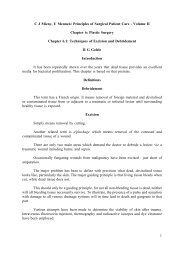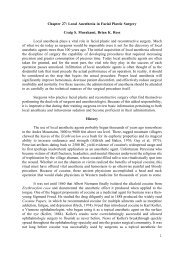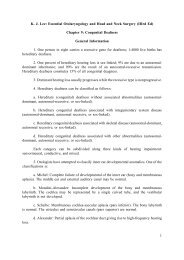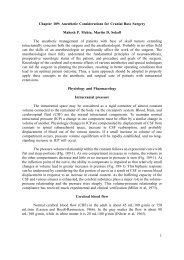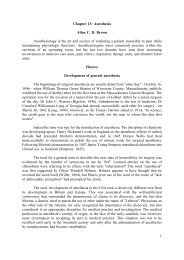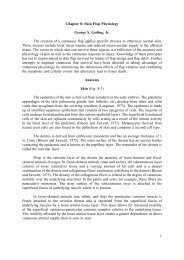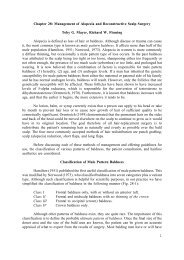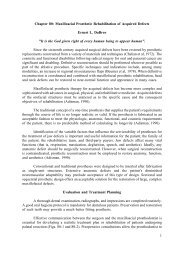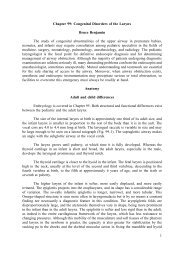1 C J Mieny, U Mennen: Principles of Surgical Patient Care - Volume ...
1 C J Mieny, U Mennen: Principles of Surgical Patient Care - Volume ...
1 C J Mieny, U Mennen: Principles of Surgical Patient Care - Volume ...
- No tags were found...
You also want an ePaper? Increase the reach of your titles
YUMPU automatically turns print PDFs into web optimized ePapers that Google loves.
Le Fort I FractureEcchimosis and/or haematoma formation is usually present in the alveolar sulcus. Theocclusion is <strong>of</strong>ten affected and associated signs <strong>of</strong> trauma may be seen on the teeth, lips andcutaneous areas paranasally.Nasal Bone FractureA displaced nasal skeleton and epistaxis are the most common initial signs. After awhile oedema <strong>of</strong> the nasal complex and paranasal region, with ecchimosis and/or ahaematoma infra-orbitally, may be seen without any clear indication <strong>of</strong> displaced nasal bones.Naso-Ethmoidal FractureA posteriorly displaced nasal complex with a deep indentation <strong>of</strong> the nasion, with orwithout laceration in that region, is indicative <strong>of</strong> this fracture. Epistaxis is initially usuallyquite severe with oedema, ecchimosis, or a haematoma paranasally and infraorbitally. Atraumatic telecanthus, thus the lateral displacement <strong>of</strong> the medial canthus ligaments, is alwayspresent with this fracture (fig. 5.3.7). An anterior cranial fossa fracture may be expected withthe usual clinical sign <strong>of</strong> cerebrospinal rhinorrhea.Medial Orbital Blow-Out FractureIn the initial phase only periorbital oedema may be present. In rare instances there maybe subconjunctival bleeding next to the cornea. The patient usually complains a few days later<strong>of</strong> a diplopia, especially with lateral and medial eye movement. An endophthalmus may alsobe seen as one <strong>of</strong> the more unusual clinical signs.Le Fort II FractureThe patient has a typical dishface appearance because the mid-facial region isdisplaced posteriorly and inferiorly. Ecchimosis and haematoma are present infraorbitally andthere is a rapid increase in oedema <strong>of</strong> the mid-face with a blepharospasm. Epistaxis is quitecommon, but a cerebrospinal rhinorrhea occurs rarely.Early dental contact posteriorly with no occlusion <strong>of</strong> the anterior teeth is the rule. Thepatient can thus not close the mouth and might also have airway obstruction due to thepostero-inferior displacement <strong>of</strong> the mid-face (fig. 5.3.8). This displacement is also presentin the s<strong>of</strong>t palate which is relocated in its relationship to the oropharynx.Arcus FractureWhen there is no oedema, a marked depression can be seen between the lateral orbitalmargin and the tragus. The patient is usually unable to open or close the mouth or if able todo so, then only with great discomfort. Ane ecchimosis or haematoma rarely develops in thisregion.26



